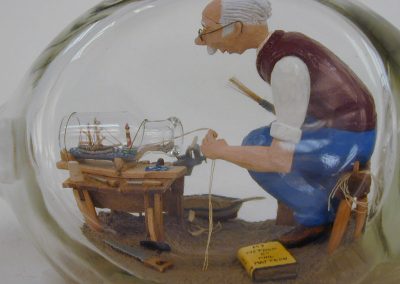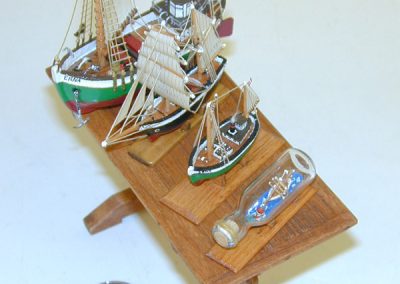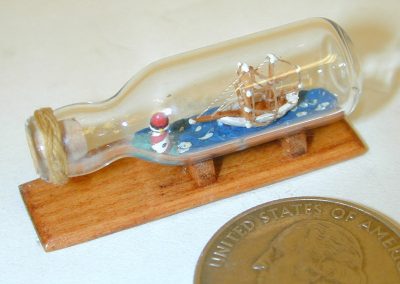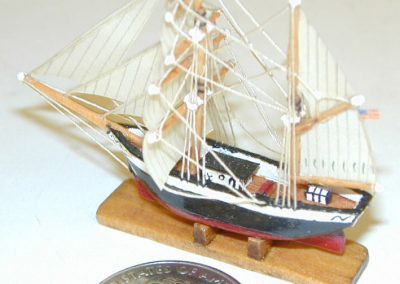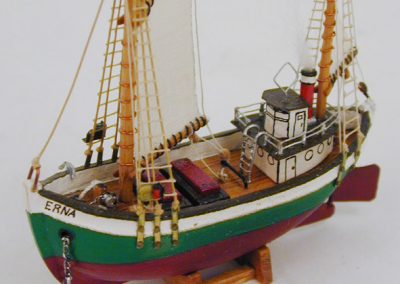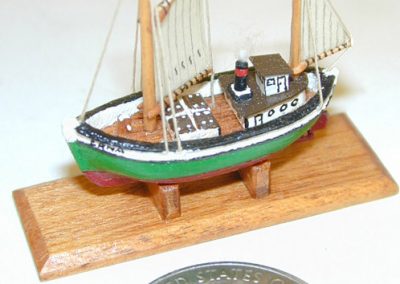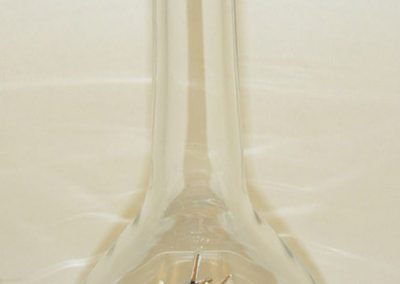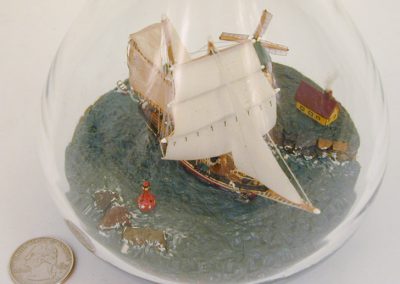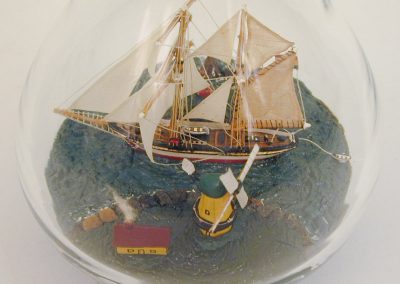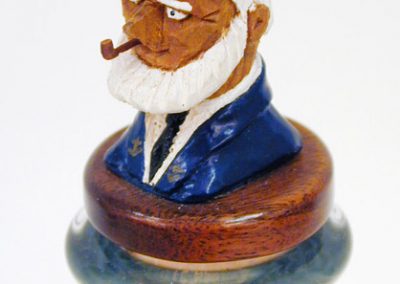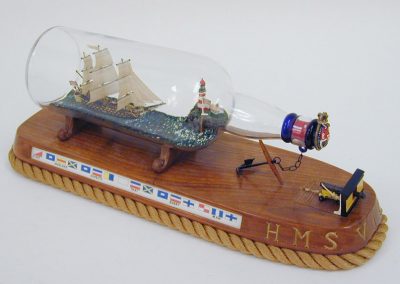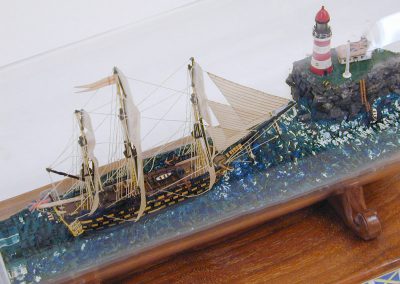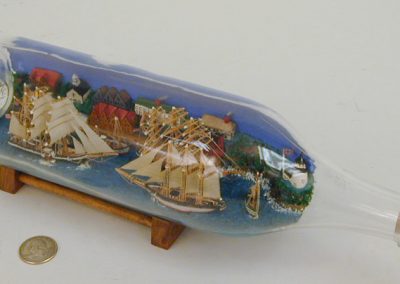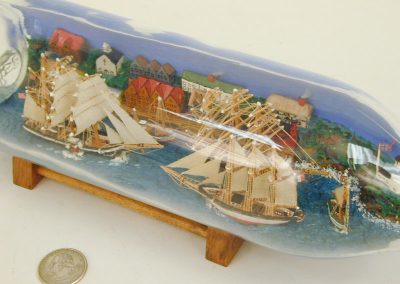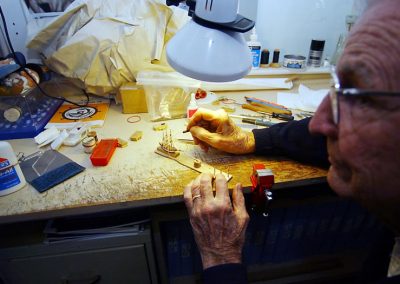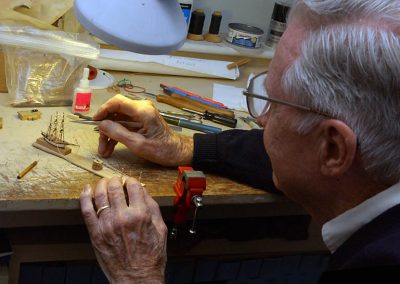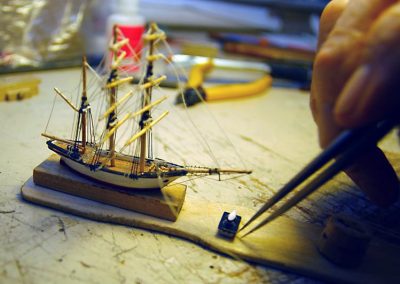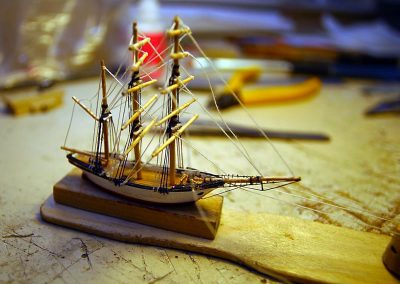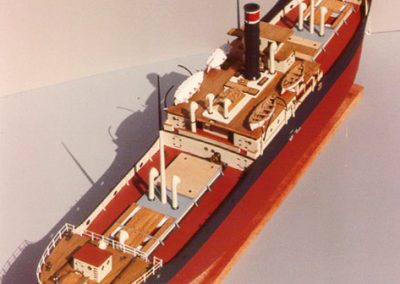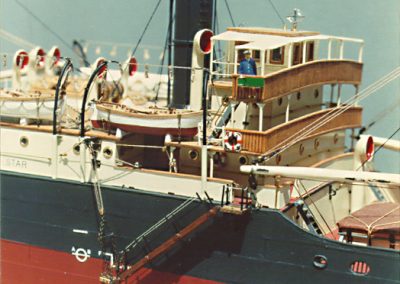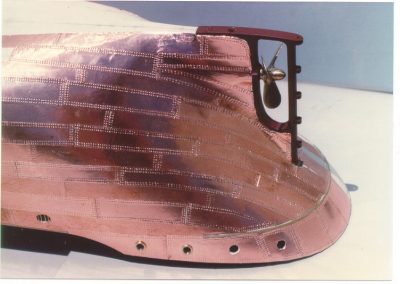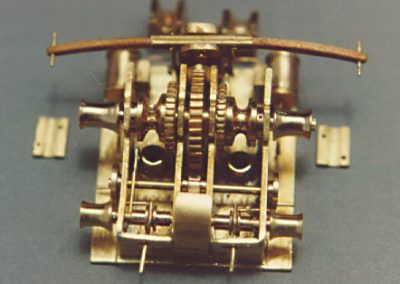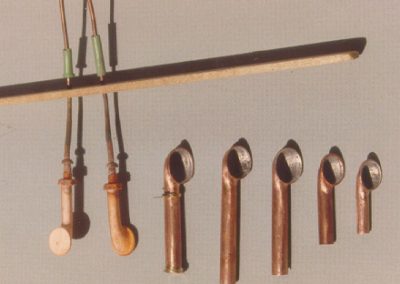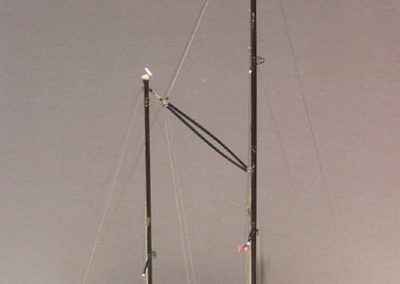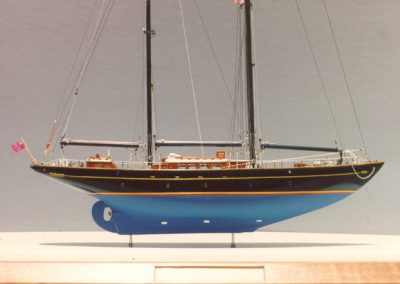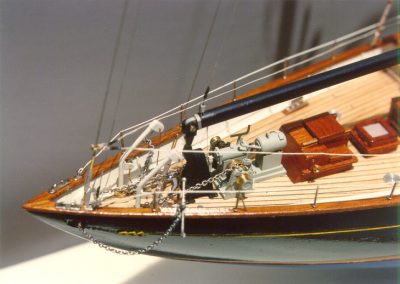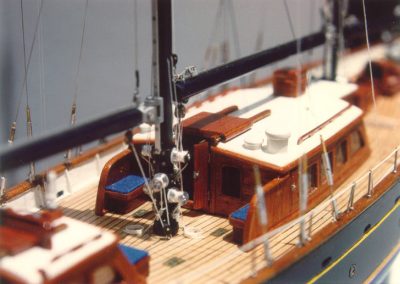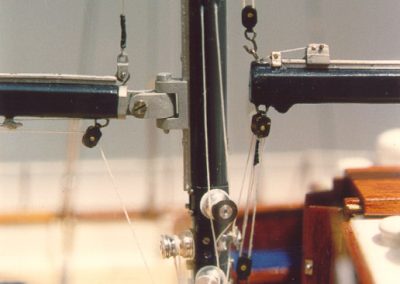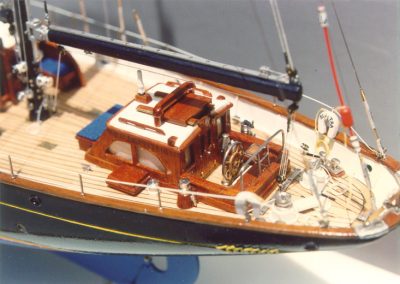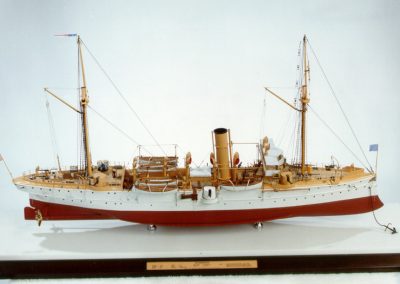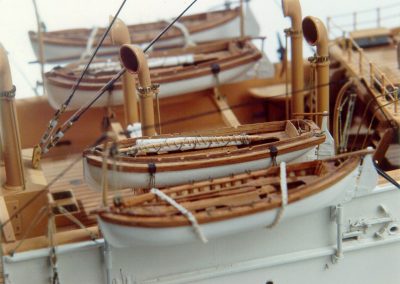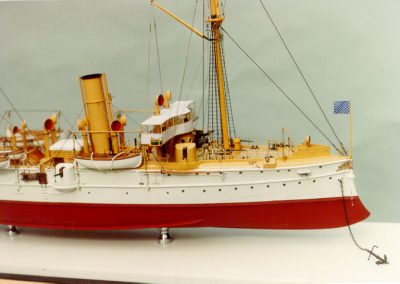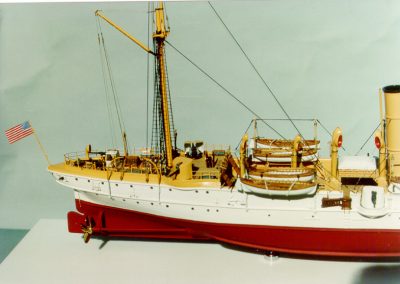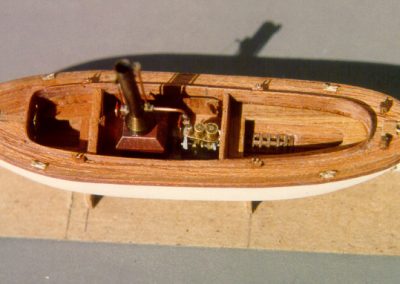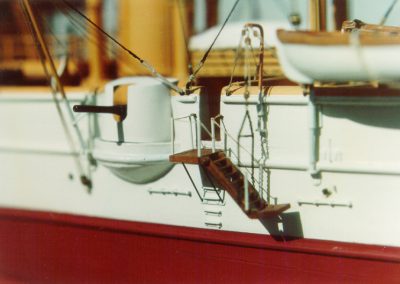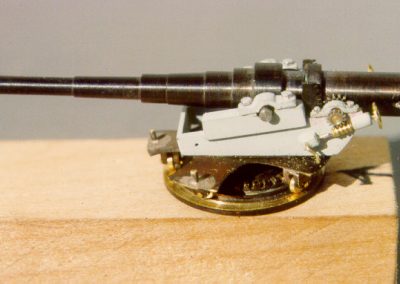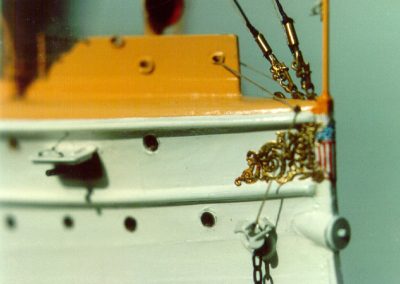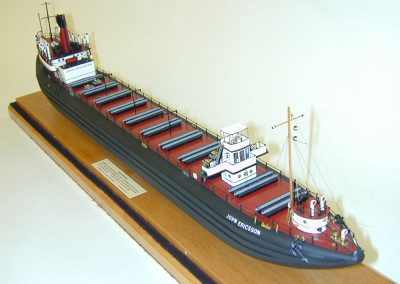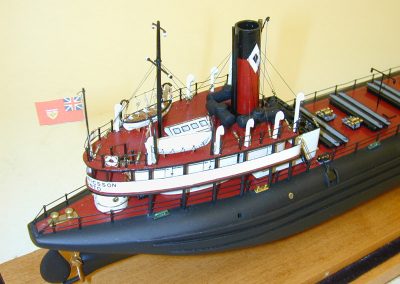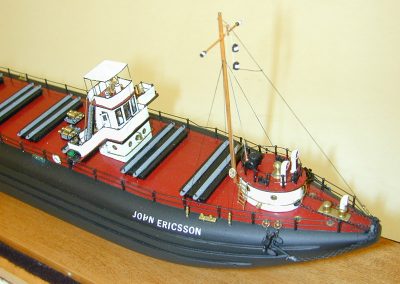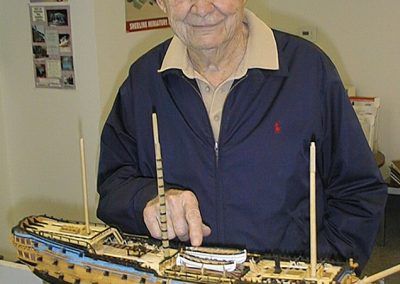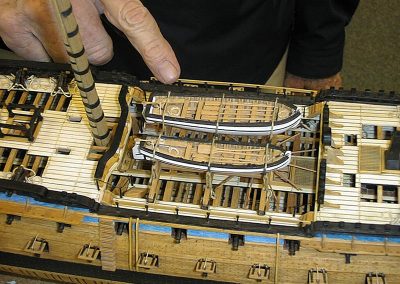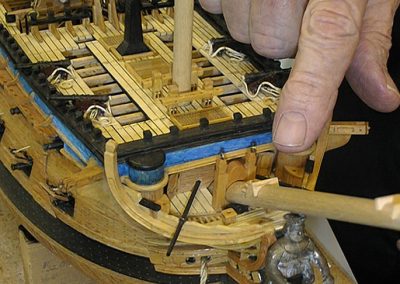Below you can view more photos of Phil Mattson’s remarkable scale model ships. Click on images to enlarge.
Miniature Ships and Ships in Bottles
Ship in a Bottle
This close-up shows the builder and his tools, plus a small book entitled, “My Method” by Phil Mattson. The white-haired modeler is pulling the string to raise the rigging on the tiny ship in his bottle. He is surrounded by the tools of his trade. This piece demonstrates the combination of art and craftsmanship that is typically only achieved at the highest levels of expertise. The table, and any other items too big to fit through the neck, were assembled inside the bottle.
Several Tiny Ships
This tiny table displays several very small ship models, with the smallest being inside a bottle. A quarter gives scale reference. The following four photos show each project in greater detail.
Ship in a Bottle
As if building any ship in a bottle wasn’t enough of a challenge, imagine making one this small! The scene inside the bottle is about the width of a quarter.
Miniature Ship
This slightly larger ship also displays plenty of detail, particularly in the rigging.
Miniature Norwegian Trawler
This is a model of the same Norwegian trawler pictured before, but built at about half the size. It has plenty of detail, despite its small size. Projects at extremely small scales are often built to hone a modeler’s skill and dexterity.
Ship in a Bottle
This tall, thin bottle features a ship with a house and windmill on the headland in the background. The ship is the Yankee, which was made famous by Captain Johnson and his wife. The pair trained college students to sail during their travels around the world. Topping the bottle is a cork with a hand-carved figure of a ship’s captain.
Ship in a Bottle
This starboard view of the Yankee shows the bow rigging, and a buoy off the headland—marking some dangerous rocks. Using this tall bottle presented assembly and rigging problems that differed from those encountered using a more traditional horizontal bottle.
Ship in a Bottle
On the headland is a windmill and lighthouse. This view presents a better look at the details in the rigging. A tiny dory is towed on a line behind the ship.
Hand-Carved Cork
A close-up of the hand-carved cork at the top of the bottle reveals plenty of character in the pipe smoking, white-haired captain.
Ship in a Bottle
This larger model of the HMS Victory incorporates a fancy stand into the display. Around the base are semaphore flags announcing Admiral Nelson’s famous message to the fleet: “England expects that every man will do his duty.” A canon sits at the front of the display, and an anchor is connected to a ring near the neck. The cork displays the royal coat of arms. The bottle was modeled after the shape of a Dewar’s scotch bottle, but was custom-blown by a friend of Phil’s to achieve better optical purity.
Ship in a Bottle
The HMS Victory is seen under full sail, passing the Eddystone Lighthouse on the point at Portsmouth, England. Whitecaps sparkle on the windblown blue water. On the original ship, Admiral Nelson defeated the combined French and Spanish fleets at the Battle of Trafalgar. Unfortunately, he was shot by a sniper and died on the ship during the battle. However, his smaller fleet won a critical victory for England.
Ships in a Bottle
Captured inside of this 12” long bottle is a busy harbor scene. It depicts the town of Bergen, Norway as it might have looked about 100 years ago. Six ships can be seen either tied up at the dock or under sail. This project was inspired by a photo in National Geographic magazine. Small buildings line the backdrop, and a lighthouse sits on the point near the neck of the bottle. This scene shows both steam and sail powered ships, illustrating the transition period between both methods of propulsion.
Ships in a Bottle
Making the ships face different directions inside the bottle creates an added level of difficulty for the builder. Different methods of raising the rigging must be used depending on the ship’s orientation to the neck of the bottle. In this detailed scene, note the waves coming off the paddles of the side-wheeler, and the smoke coming from chimneys in the background. Consider the preparation and foresight that must go into a project like this.
Phil at Work
The following four photos were taken in June, 2005 by Lance Cpl. James Hoke, from Marine Corps Air Station Miramar Public Affairs. Mr. Hoke wrote for the station’s newspaper, The FlightJacket, and the Marine Corps website.
Phil at Work
Mr. Hoke took these photos of Phil Mattson at work for an article on the San Diego Maritime Museum.
Museum Display Models
The Pacific Star
The Pacific Star
An aerial view of the Pacific Star, built at a scale of 1/8″:1′. The original boat was powered by steam, fueled with coal, and could move at up to 10 knots.
The Pacific Star
Amidships view shows the boarding ladder in the down position. Details of the bridge, lifeboat, boarding ladder, and stack can also be seen.
The Pacific Star Hull
To achieve the look of a riveted steel hull, Phil made a jig to press rivet patterns into sheets of thin copper. The many sheets were glued on in an overlapping pattern to cover the entire hull. Once painted, the hull resembles a realistic steel boilerplate hull with thousands of rivets!
The Pacific Star Anchor Winch
Many parts, like this anchor winch in the bow, were machined from multiple pieces of metal. By doing so, the components accurately represent the function of the original deck gear. The steam driven winch could also be manually operated by a wooden rocker arm beam at the rear.
Copper Ventilation Funnels
Phil developed a very clever technique to make these hollow copper ventilation “funnels.” First, he carved a wooden model from which a mold was taken. A low melting point metal, called “Cerro-Bend,” was then poured into the mold. The solid metal funnel was then attached to electrodes, and placed in a copper plating tank until a sufficient plating thickness was achieved. The Cerro-Bend was then melted out, leaving a hollow copper funnel which was trimmed to shape and painted.
The Sintra
The Sintra
The original Sintra was berthed in San Diego Harbor, where Phil photographed the details for his 3/16”:1’ scale model. The full-size boat was a steel hull wishbone ketch, built in 1959. It had an overall length of 94’, a beam of 20’, and a draft of 11’-5”. The ship carried 5000 square feet of sail, and had a 450 HP Diesel power plant. Phil built this model of the Sintra in 1989-90.
The Sintra
A starboard view of the hull shows the ship’s graceful lines. The black and blue color scheme adds a dramatic tone. There were no drawings available of the original ship for Phil to consult. Instead, the model was built strictly from photos.
The USS Bennington
The USS Bennington
The USS Bennington was part of the “Great White Fleet” in the Philippines during the 1890’s. That fleet was in place to display American military strength in the region. The captain of the Bennington placed an American flag on Guam for the first time. However, the ship later had the dubious distinction of being involved in the worst peacetime naval accident in US history at the time. On July 21, 1905, the boiler of this gunship exploded as it was preparing to get underway in San Diego Harbor, killing 65 men. Phil’s model of the ship is shown here on its display base. (Photo: Mike Barth)
The USS Bennington
Lifeboats can be seen in this photo. The original ship was 244’ long, had a beam of 36’, and a draft of 14’. It was powered by two 1500 HP steam engines, had a range of 4200 nautical miles, and could reach speeds up to 17.5 knots. (Photo: Mike Barth)
The USS Bennington Steam Launch
A closer look at the captain’s steam-powered launch. The miniature steam engine was machined from many brass parts.
USS Bennington Deck Gun
The larger deck guns consist of many machined brass components. Racks, gears, and other mechanisms were duplicated in great detail. Note the worm gear elevation mechanism, and round rack gear rotating mechanism. These were made from drawings from the naval gun factory, which were obtained by the Maritime Museum.
The John Ericsson
The John Ericsson
The full-size ship was 396’ long, with a 48’ beam, and a 21’ draft. It displaced 3200 tons. Phil’s model is 24.75” long. The original ship was a good freight hauler; however, it was not popular with all skippers because it was difficult to handle in heavy winds when empty, as it tended to “weathervane.”
The John Ericsson
Details of the rear superstructure and lifeboats can be seen here, along with the brass propeller. The hull of this ship looks somewhat like a submarine, and was designed so that the decks would be awash in rough seas.
The HMS Alfred
Phil Mattson With His HMS Alfred
Phil is shown here with one of his last projects, the 74-gun British ship of the line—the HMS Alfred. It was built from plans by Harold M. Hahn. The original ship was launched on October 22, 1778. The model is planked only down to the waterline, so the internal structure of the ship is visible, too.
The HMS Alfred
Here Phil points to some of the deck details, including the lifeboats. The boats were removable so that the anchor winch could be seen below deck. Planks were held on with several thousand “tree nails,” or tiny round dowels of wood exactly like the original.
The HMS Alfred
If you’ve ever wondered why they call it a “head,” the original bathrooms were at the very front of the ship, as Phil points to in this photo. They were simply holes that dumped waste straight down into the water. There are four open seats here, and an enclosed officer’s head. Note also that Phil cast the figurehead in bronze.

